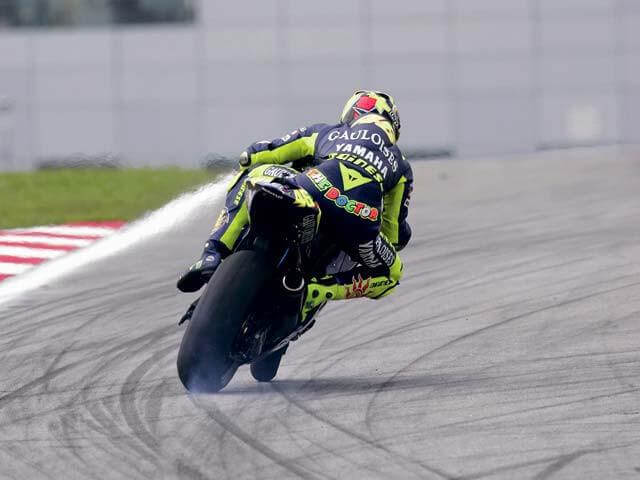RIDING SKILLS: Throttle Control

Scenario 1:
This time, you slow down even more for the same corner. The bike doesn’t go wide anymore but it feels sluggish in mid-corner. The front feels like it’ll wash out at any time and the whole bike feels like it’s going to just topple over.
Scenario 2:
You’ve turned into the corner at what seems to be the correct speed, yet you’re still going wide. You tap the front brakes but the bike stands up and now you’re heading into the grass.
I touched on countersteering in the previous article, so now it’s on how throttle control plays another important part in motorcycle control.
First, we need to remember that a motorcycle transfers the load is carries.
When you slam open the throttle and the bike bursts forward in acceleration, you’ll feel your body and weight of the motorcycle (let’s add them together and call it “load”) being transferred to the rear, and the front tyre becoming “light”. The reverse is true when you brake, as the load gets pitched forward onto the front suspension and tyre.
Pro riders have always exploited these chassis dynamics to their advantage.
The motorcycle slows down naturally in any corner — if you keep the throttle off or stay on steady throttle — due to the centripetal force pulling the bike to the outside of the turn through its centre of gravity. Hence, if the throttle stays off for too long, the load will start to transfer to the front wheel, causing the front tyre’s contact patch to expand (called “tyre deflection”).
When that happens, the bike will feel sluggish and hard to turn, sending the bike to the outside of the corner. In extreme cases, the load overwhelms the grip of the tyre and causes it to slide under, resulting in what’s called a lowside.
So what do you do?
Try this:
- Look for your desired cornering line and apex before you turn in
- Once you’ve turned and the bike’s heading to the apex, crack open the throttle and keep rolling it in a smooth and even manner
- As you clear the apex, start lifting the bike up while adding more throttle
- Roll the throttle all the way when the bike has stood up completely
The above steps are part of what Keith Code calls Throttle Rule No. 1. It goes like this, “Once the throttle is cracked open, it is rolled on smoothly, evenly and continuously, throughout the remainder of the turn.”
Repeat that to yourself every time you ride until it becomes second nature.
It essentially means that once you open the throttle in a corner from a closed position, you need to keep rolling it open more and more. No steady throttle, no on-off maneuvers, no slamming it open suddenly, no chopping it off.
Additionally, it doesn’t mean that you should only reopen the throttle before the apex, at the apex, of after the apex specifically, but as soon as possible.
Early throttle application balances out the bike’s dynamics, by keeping excess load off the front tyre. You will find that it’s actually easier to steer through when you turn the gas on.
Besides that, we often hear new riders asking which cornering line is the best. While there’s a “fast” line around a racetrack or road, the best line is effectively the one that follows Throttle Control Rule No. 1, as in the line that allows you to get on the gas as soon as possible.
Another aspect of throttle control which cannot be over emphasised is how it affects traction.
Again, that has to do with weight transfer. Remember that keeping the throttle closed for too long will load up the suspension and tyres unnecessarily. On a racetrack, you will find the competitor in front pulling many meters away from you. Also, you may find your tyres overheating too soon. On the road, it could even become dangerous.
Opening the throttle has the effect of lifting the bike up, consequently extending the suspension and unloading the tyres. This results in the suspension and tyres being able to do their job more effectively in soaking up the bumps on the road surface. Fully loaded suspension and tyres will be overwhelmed by the bumps and cause a loss of traction.
Another aspect of throttle control is managing a seemingly out of control motorcycle when it slides. You know, you’re flying through a corner when the tyres suddenly threaten to slide into the countryside.
What do you? Chop the throttle?
As with Throttle Control Rule No. 1, if you chop the gas suddenly, load will be transferred onto the front tyre abruptly. The contact patch spreads out, causing the bike to slow down drastically. Next, the rear tyre unloads even more, causing it to slide around faster and harder, resulting in a “lowside”. Worse, if the sliding tyre regains grip abruptly and flings you over the top, known as the dreaded “high side”.
Again, the answer lies in how you control your right hand.
The best bet is to countersteer on the outside handlebar to lift the bike up slightly and roll off the gas. An advanced technique, if you learn motocross, is to actually throttle up when the bike slides.
Why? Because the motorcycle is actually looking for a stable position when it slides. Just remember to not panic, apply Throttle Control Rule No. 1 and ride it out. Do you see Rossi going off the gas or turning it on when his bikes slides and wobbles? Look closely and you’ll see he’s opening the throttle.
In conclusion, learn to open your throttle earlier to help you turn better. Think of the throttle as a control interface, rather than just an on/off switch.